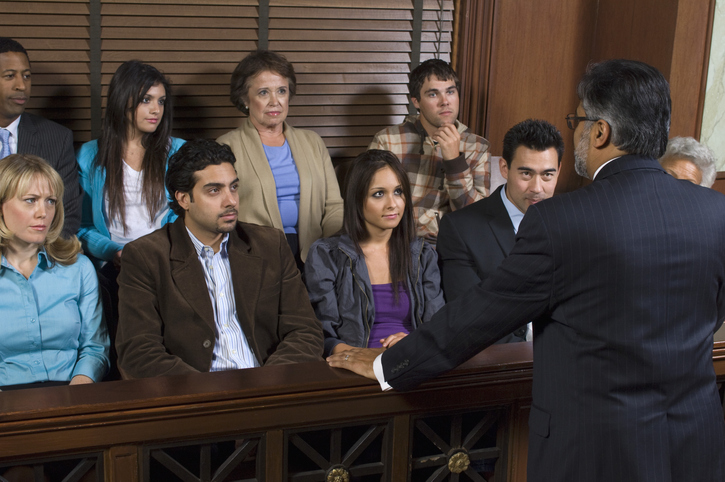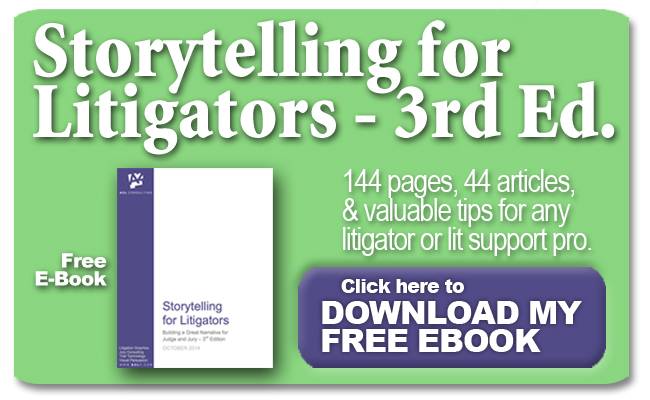This article is the last in a series of four articles about courtroom storytelling. My goal in this series is to reveal some of the tricks of the persuasive storytelling trade in one place for the busy trial lawyer. I hope that these recommendations can serve as a pretrial checklist for anyone who wants to draft an opening statement.
A2L’s litigation consultants have published dozens of articles about storytelling, and we’ve released books and webinars on the subject. These ten tips represent the essence of what we have learned and of what we have taught. If you apply these ten suggestions when developing your story for trial, your story will be more persuasive, and you will radically increase your chances of winning your case.
Tip #6. Your audience MUST care about the story. The audience should be emotionally transported. It has been said, “People will forget what you said, people will forget what you did, but they will never forget how you made them feel.”
Scientific studies show that when people listen to an effective story, their brains react more like participants than spectators. When we say that people experiencing a deep connection are “on the same wavelength,” there is neurological truth to that.
Scientists at Princeton University looked at brain scans (fMRI) of storytellers and listeners to the stories. They found that the most active areas of the brains of the speakers and listeners matched up; they were in sync or coupled. However, this synchronized activity was found in the areas of the brain relevant to theory of mind, not in areas that drive memory or the prefrontal cortex associated with cognitive processing. The stronger the reported connection between speakers and listeners, the more neural synchronicity was observed in the test subjects. The extent of brain activity synchronicity predicted the success of the communication – so connecting with your audience more makes you more persuasive. Source: Storytelling Proven to be Scientifically More Persuasive.
Tip #7. Force participation of your audience. Engage the audience in the journey. As Pixar film director Andrew Stanton says, don’t give them 4, give them 2+2 and make them work to find the answer. Nineteenth-century writer William Archer wrote, “Drama is anticipation mingled with uncertainty.” Make your audience members keenly aware of their uncertainties and holding on to their sense of anticipation.
The goal of a presentation is always the same -- to engage the audience, to move them. This holds true regardless of the stage. It’s so in the courtroom, on the floor of the U.S. Congress, in the boardroom, and in the classroom. Litigators engage a jury to win their case for their client; professors engage their students so that they can best teach the subject matter. Engagement leads to better understanding, which then leads to better retention and enhanced persuasiveness. Retention and understanding are the keys to success.
Tip #8. Use the “Belief –Action-Benefit” trilogy to bring the audience in and to engage them. This is a technique that works because it shows the audience why they should care about what you are saying and why they should take your side.
The classic trilogy goes as follows: I believe ____, I think you should do _____, and if you do, the benefit will be _____. Then go into detail about what you believe, what actions you want your audience to take and how they will benefit by doing so. Finally, repeat your initial belief-action-benefit statement.
This process needs to be modified in a trial situation. What a lawyer believes is not really relevant to an opening statement, so the belief-action-benefit approach needs to be couched a bit differently -- more like “Plaintiffs, self-described patent trolls, are attempting to wrongfully extort money from my client. You have a chance to make this right. If you do, you'll be standing up for small business and all that is just and right.”
Tip #9. Tell the truth. One trial attorney friend of mine likes to say that you should never write bad checks in opening statements. That is, you must faithfully deliver on the promises you make in opening. If the jury comes to believe that you are not delivering – that you are overpromising and underdelivering the facts – they will not trust you. The fragile web of trust will be gone and you will be viewed as just another lawyer who plays fast and loose with the truth.
Don’t oversell your case. If you know you cannot prove something, don’t say you can. Promising more than you can deliver will hurt your case and may constitute reversible error. Rob Cary, a litigation partner at Williams & Connolly, has said, “Being a litigator is about storytelling, making a narrative that makes sense and that is credible and reasonable. So much of what is taught in law school is so complicated and so nuanced that it inhibits good storytelling. So I think all lawyers when they get out there, and especially if they practice before jurors, need to be good storytellers. It is crucial to stick to the truth, and of course you need to be able to show as well as to tell.”
Tip #10. Use your life experiences to convey authenticity. Great trial lawyers are usually good actors. They can convincingly make a jury believe they are indignant, sorrowful, or have any range of useful emotions.
A well-known acting technique that applies to courtroom storytelling involves recalling one’s life experiences to be able to reproduce seemingly authentic emotions. In the courtroom, I recommend taking this technique one step further. Instead of simply drawing on life experiences to make yourself feel a particular way, instead, work to connect your life experiences with fact patterns in the story you build and tell at trial. Then, as you tell your trial story, you’ll more naturally connect with your own life story and express natural emotions.
The best trial lawyers have a lot of things in common. They comfortably rely on image consultants. They use acting coaches. They videotape themselves doing run-throughs, review the tapes, refine and repeat. And, more important than anything else, they practice openly in front of a group of trusted advisers -- often this takes the form of a mock trial. They spend most of their careers asking, How can I be better?
When I watch these great litigators at work, I notice that they are a great deal like the fictional depictions of lawyers in the movies. And I don't think it is an accident. They've worked with jury consultants and other consultants to slowly mold themselves into who they are now.
I've written before about how lawyers can learn a lot about trial presentation from the movies, how the litigation business is not all that unlike the movie business, and how litigators can benefit from learning to tell better stories - just like the movies. So, this got me thinking.
Since juries expect litigators to be a lot like those in the movies, and since the best in the business are not all that dissimilar from lawyers in the movies, might the gap in performance between good litigators and great litigators be the degree to which they practice?
There is a noticeable gap between the way some litigators perform in the courtroom when compared to a Glenn Close, Paul Newman, Laura Linney, Matthew McConaughey or Gregory Peck. It's not just about their hair and makeup. It's about how they present their cases, how they connect better with jurors and how they tell better stories that are more emotionally compelling.
Jump to Part 1, Part 2, Part 3, Part 4
Other A2L Consulting free resources about litigation storytelling, opening statements, and trial presentation include:
- Conflict check: Be the first to retain A2L
- Ten Ways to Maximize Persuasive Courtroom Storytelling (Part One)
- Three Top Trial Lawyers Tell Us Why Storytelling Is So Important
- Your Trial Presentation Must Answer: Why Are You Telling Me That?
- Free Download: 219-Page Opening Statements Toolkit E-Book
- Are You Smarter Than a Soap Opera Writer?
- 10 videos to help litigators get better at telling stories at trial
- Free Webinar: Storytelling for Litigators
- 11 Things Your Colleagues Pay Litigation Consultants to Do
- 21 Reasons a Litigator Is Your Best Litigation Graphics Consultant
- Free Download: Storytelling for Litigators
- 5 Essential Elements of Storytelling and Persuasion
- Storytelling Proven to be Scientifically More Persuasive
- Storytelling at Trial Works - But Whom Should the Story Be About?






Leave a Comment